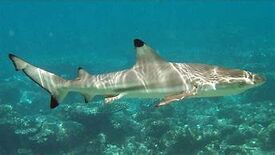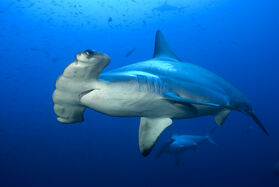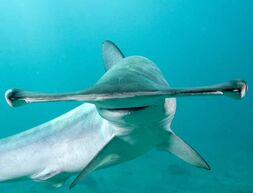Tag: Visual edit |
Tag: Visual edit |
||
| Line 2: | Line 2: | ||
== Defining Features == |
== Defining Features == |
||
| − | Defining features of the carcharhiniformes family would include a wide mouth that is located behind their eyes, |
+ | Defining features of the carcharhiniformes family would include a wide mouth that is located behind their eyes, five pairs of gill slits, an anal fin, two dorsal fins without spines, and a nictitating membrane. They are commonly referred to as "Ground Sharks". |
== Habitat and Range == |
== Habitat and Range == |
||
| − | As the largest order of sharks, Carcharhiniformes are able to be found all over the |
+ | As the largest order of sharks, Carcharhiniformes are able to be found all over the planet, often in tropical continental shelf regions. They can be found in most inshore habitats but can also be found offshore. Some species within this order are able to swim in fresh water, further broadening their habitat and range. |
== Fisheries Conservation and Concern == |
== Fisheries Conservation and Concern == |
||
| − | There is concern around many of the species in this order experiencing a decline in number. Some are exposed to habitat disturbances and destruction, while |
+ | There is concern around many of the species in this order experiencing a decline in number. Some are exposed to habitat disturbances and destruction, while others are threatened by recreational and commercial fishing. Due to the slower reproduction process of these sharks, many species in this order are highly susceptible to exploitation. |
== Closest Relatives == |
== Closest Relatives == |
||
| Line 22: | Line 22: | ||
Defining Features: Black Tip Reef sharks get their name from their recognizable fins. Each of their fins stand out with black tips. These sharks also have short and rounded snouts in front. |
Defining Features: Black Tip Reef sharks get their name from their recognizable fins. Each of their fins stand out with black tips. These sharks also have short and rounded snouts in front. |
||
| − | Range & Habitat: These sharks are not migratory, they tend not to travel out of a general area. They swim around reefs, drop offs, and continental and insular shelves. Similar to how they do not travel very far, they also tend to stay in shallower, clearer water. |
+ | Range & Habitat: These sharks are not migratory, they tend not to travel out of a general area. They swim around reefs, drop offs, and continental and insular shelves. Similar to how they do not travel very far, they also tend to stay in shallower, clearer water. They can be found in the Indo-Pacific and Eastern Mediterranean. |
IUCN Concern: Near Threatened |
IUCN Concern: Near Threatened |
||
| Line 32: | Line 32: | ||
====''Sphyrna lewini''==== |
====''Sphyrna lewini''==== |
||
| − | Defining Features: Large double-hammer shaped head. Mouth on underside. Commonly found around 5+ feet in length. |
+ | Defining Features: Large double-hammer shaped head with iconic indentation at midline. Mouth on underside. Commonly found around 5+ feet in length. |
| − | Range & Habitat: The Scalloped Hammerhead is a coastal pelagic species; it occurs over continental and insular shelves and in nearby deeper water. It is found in warm temperate and tropical waters. It can be found down to depths over 500 m, but is most often found above 25 m. |
+ | Range & Habitat: The Scalloped Hammerhead is a coastal pelagic species; it occurs over continental and insular shelves and in nearby deeper water. It is found in warm temperate and tropical waters. It can be found down to depths over 500 m, but is most often found above 25 m. The Scalloped Hammerhead is distributed globally. |
IUCN Concern: Critically Endangered |
IUCN Concern: Critically Endangered |
||
| Line 46: | Line 46: | ||
==== ''Sphyrna zygaena'' ==== |
==== ''Sphyrna zygaena'' ==== |
||
| − | Defining Features: Very flat and smooth hammer-head. No indentation in middle of head. |
+ | Defining Features: Very flat and smooth hammer-head. No indentation in middle of head. The Smooth Hammerhead is dark olive to brownish-gray with a white ventral side. |
Range & Habitat: A highly mobile species that can be found worldwide in coastal, temperate and tropical waters. Smooth Hammerheads typically stay in shallow waters around 20 m deep but have been spotted at depths up to 200 m. |
Range & Habitat: A highly mobile species that can be found worldwide in coastal, temperate and tropical waters. Smooth Hammerheads typically stay in shallow waters around 20 m deep but have been spotted at depths up to 200 m. |
||
Revision as of 04:20, 11 August 2020
Defining Features
Defining features of the carcharhiniformes family would include a wide mouth that is located behind their eyes, five pairs of gill slits, an anal fin, two dorsal fins without spines, and a nictitating membrane. They are commonly referred to as "Ground Sharks".
Habitat and Range
As the largest order of sharks, Carcharhiniformes are able to be found all over the planet, often in tropical continental shelf regions. They can be found in most inshore habitats but can also be found offshore. Some species within this order are able to swim in fresh water, further broadening their habitat and range.
Fisheries Conservation and Concern
There is concern around many of the species in this order experiencing a decline in number. Some are exposed to habitat disturbances and destruction, while others are threatened by recreational and commercial fishing. Due to the slower reproduction process of these sharks, many species in this order are highly susceptible to exploitation.
Closest Relatives
Lamniformes
Example Species in Carcharhiniformes

Black Tip Reef Shark
Carcharhinus melanopterus
Defining Features: Black Tip Reef sharks get their name from their recognizable fins. Each of their fins stand out with black tips. These sharks also have short and rounded snouts in front.
Range & Habitat: These sharks are not migratory, they tend not to travel out of a general area. They swim around reefs, drop offs, and continental and insular shelves. Similar to how they do not travel very far, they also tend to stay in shallower, clearer water. They can be found in the Indo-Pacific and Eastern Mediterranean.
IUCN Concern: Near Threatened

Ref: https://haydensanimalfacts.com/2015/10/30/5-interesting-facts-about-scalloped-hammerheads/
Scalloped Hammerhead
Sphyrna lewini
Defining Features: Large double-hammer shaped head with iconic indentation at midline. Mouth on underside. Commonly found around 5+ feet in length.
Range & Habitat: The Scalloped Hammerhead is a coastal pelagic species; it occurs over continental and insular shelves and in nearby deeper water. It is found in warm temperate and tropical waters. It can be found down to depths over 500 m, but is most often found above 25 m. The Scalloped Hammerhead is distributed globally.
IUCN Concern: Critically Endangered
Example Species in the Gulf of Maine

Ref: http://animal-unique.blogspot.com/2011/09/smooth-hammerhead-shark.html
Smooth Hammerhead
Sphyrna zygaena
Defining Features: Very flat and smooth hammer-head. No indentation in middle of head. The Smooth Hammerhead is dark olive to brownish-gray with a white ventral side.
Range & Habitat: A highly mobile species that can be found worldwide in coastal, temperate and tropical waters. Smooth Hammerheads typically stay in shallow waters around 20 m deep but have been spotted at depths up to 200 m.
IUCN Concern: Critically Endangered
References
Florida Museum of Natural History: floridamuseum.ufl.edu
Shark Sider: sharksider.com
IUCN Redlist: iucnredlist.org
Chondrichthyan Tree of Life: sharksrays.org
National Oceanic and Atmospheric Administration: noaa.gov
Fish Base: fishbase.org